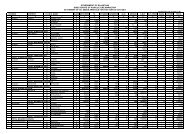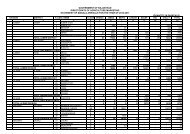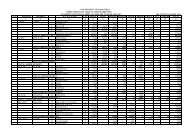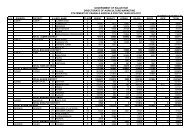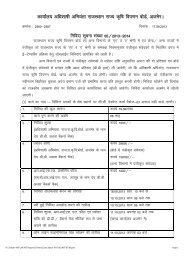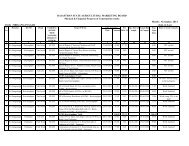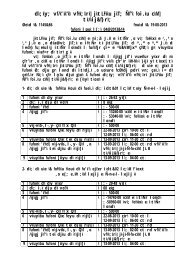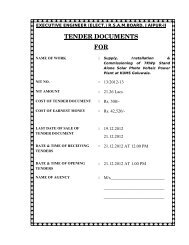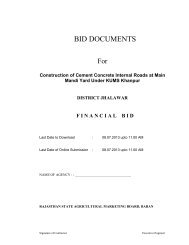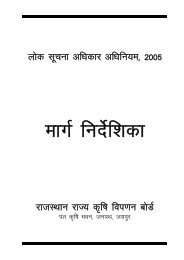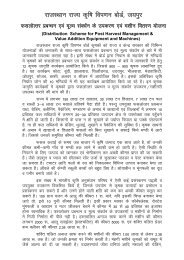Terms of reference - Rajasthan Agriculture Marketing Board
Terms of reference - Rajasthan Agriculture Marketing Board
Terms of reference - Rajasthan Agriculture Marketing Board
- No tags were found...
Create successful ePaper yourself
Turn your PDF publications into a flip-book with our unique Google optimized e-Paper software.
<strong>Terms</strong> <strong>of</strong> Reference<strong>Terms</strong> <strong>of</strong> Reference for engagement <strong>of</strong> a Consultancy Firm for <strong>Rajasthan</strong>Agricultural Competitiveness project (RACP) preparation proposed for WorldBank Funding :1. BackgroundThe Government <strong>of</strong> <strong>Rajasthan</strong> looking to the need <strong>of</strong> improving productivity <strong>of</strong> cropsand to ensure better returns <strong>of</strong> produce to the farmers and maximize farm income bya coordinated approach focusing on best utilization <strong>of</strong> the available water, cropdiversification, value addition in agriculture sector along with emphasis on livestockdevelopment has agreed to apply for a credit/loan from World Bank for funding<strong>Rajasthan</strong> Agricultural Competitiveness Project. The project would cover general<strong>Agriculture</strong>, and forestry sector ,Agricultural marketing and trade, Agriculturalextension and research , Animal production At the concept review meeting betweenthe World Bank and Government <strong>of</strong> <strong>Rajasthan</strong>, a decision was taken to proceed withthe preparation <strong>of</strong> the <strong>Rajasthan</strong> Agricultural Competitiveness Project in the Statewith immediate launch in two clusters Tonk and Udaipur. The overall responsibilityfor the project execution will rest with the <strong>Rajasthan</strong> State <strong>Agriculture</strong> <strong>Marketing</strong><strong>Board</strong> (RSAMB) through allied departments like the Department <strong>of</strong> AnimalHusbandry, Department <strong>of</strong> Horticulture, Water Resources Department includingGround Water Department, RD & Panchayati Raj Department and for researchsupport State Agricultural Universities, CAZRI and other research institutes locatedin <strong>Rajasthan</strong>.2. <strong>Rajasthan</strong> context<strong>Rajasthan</strong>, the largest State in India is spread over an area <strong>of</strong> 3.42 lakh Sq. Km,which is 10% <strong>of</strong> the area <strong>of</strong> the country. The State’s population as per the census <strong>of</strong>2011 is 68.62 million, which is nearly 5.5% <strong>of</strong> Country’s population. 77% <strong>of</strong> State’spopulation resides in the rural areas.The State’s economy has undergone a considerable transformation in the recentpast with growth <strong>of</strong> manufacturing and services sectors. However, agriculture, withover 60% <strong>of</strong> the State's population dependant on it, continues to play an importantrole. <strong>Agriculture</strong>, including animal husbandry, contributes about 25% to the State’sGross Domestic Product. Growth <strong>of</strong> the agriculture sector therefore has an importantimpact on State’s economic performance and more importantly on the lives <strong>of</strong> peopledependent on agriculture.The State has 342.66 lakh hectare <strong>of</strong> area reported for land utilization purpose. Out<strong>of</strong> this, 7.76% (26.60 lakh hectare) is under forest cover and 12.43% (42.59 lakhhectare) is not available for cultivation consisting <strong>of</strong> 5.14% (17.60 lakh hectare)under non-agricultural usage and 7.29% (24.98 lakh hectare) <strong>of</strong> barren anduncultivated land. Fallow land is estimated 10.75% (36.82 lakh hectare) whichincludes 3.72% (12.75 lakh hectare) current fallow and 7.02% (24.07 lakh hectare)other fallow land. Other uncultivated lands excluding fallow land is estimated 18.35%(62.69 lakh hectare) which includes 4.98% (17.08 lakh hectare) under permanentpastures and grazing land, 0.04% (0.14 lakh hectare) under miscellaneous treecrops and grooves and 13.27% (45.46 lakh hectare) <strong>of</strong> culturable waste lands.
Estimated net sown area is approximately 173.94 lac hectare and the gross croppedarea is around 216.64 lakh hectares.Average farm size in <strong>Rajasthan</strong> is 3.96 ha, and total number <strong>of</strong> land holdings is 5.36million. Small and marginal holders represent one-half <strong>of</strong> the total number <strong>of</strong> farmhouseholds, but they share just 16% <strong>of</strong> the cultivated land The rain-fed crops onwhich they are so dependent are grown in an extremely hostile agro-climaticenvironment, with temperatures varying from a minimum <strong>of</strong> 5ºC to a maximum <strong>of</strong>45ºC and more. Rainfall variations are large, both in space and in time, with annualprecipitation ranging from 15 to 90 cm in different parts <strong>of</strong> the State.While the State has over 10% <strong>of</strong> the country’s geographical area, 5% <strong>of</strong> itspopulation and 13% <strong>of</strong> the area under cultivation, it has only less than 1% share inthe water resources. Water, clearly, is State’s most precious resource. In absence <strong>of</strong>perennial sources, there has been overdependence over ground water, leading tomining <strong>of</strong> water in many parts <strong>of</strong> the State. Besides its quantity, the quality <strong>of</strong> water isanother major concern. What is even more disconcerting is that nearly two third (4.5million ha.) <strong>of</strong> the irrigated area is dependent on underground water from wells andtube wells. Most <strong>of</strong> the area irrigated by canal system is in the northern part <strong>of</strong> theState where the Indira Gandhi Nahar Project (IGNP), Gang and Bhakra Canalssystems irrigate more than 1.7 million hectares.<strong>Rajasthan</strong>’s climate is marked by frequent droughts, a short monsoon season (Julyto September) resulting in annual rainfall ranging from 150 to 900 mm in differentpart <strong>of</strong> the state (average annual mean: 576 mm) and temperatures ranging from 5Cto 45C and more. The Aravalli range runs from the south-west <strong>of</strong> <strong>Rajasthan</strong> to thenorth-east. To its west lies the Thar Dessert which covers over 60 percent <strong>of</strong> thestate’s land area and leaves <strong>Rajasthan</strong> actually deficient in water supply. <strong>Agriculture</strong>continues to be largely dependent on rainfall. Leaving the state highly vulnerable todrought induced volatility. <strong>Rajasthan</strong>’s development strategy needs to take intoaccount wide variations in geographical terrain and climatic conditions as well as insocial structures within the State.For State as a whole, food grains occupy around 66% <strong>of</strong> cultivated area duringKharif and 58% area during Rabi season. Important Kharif season food grain cropsare pearl millet, maize, sorghum and paddy in cereal and black gram, green gramand pigeon pea in pulses. Wheat and Barley in cereals and gram in pulses are majorfood grain crops during Rabi season. Oil seed crops occupying large areas duringKharif season are soybean, groundnut, sesame and rape mustard and linseed duringRabi season. It is pertinent to mention that <strong>Rajasthan</strong> is India’s largest producer <strong>of</strong>mustard (oilseed crop), pearl millet (known as bajra), three spices: coriander, cuminand fenugreek; cluster beans, isabgol and it is the second largest producer <strong>of</strong> maize.<strong>Rajasthan</strong> has the second largest herd <strong>of</strong> livestock amongst Indian states,contributing about 10 percent <strong>of</strong> the country’s milk and 30 percent <strong>of</strong> muttonproduction.3. Project objectivesThe Project would adopt a participatory and interdisciplinary approach to promote adetailed understanding <strong>of</strong> how cropping systems operate in the project areas
(Regional cluster approach covering 2 to 3 blocks or a district) under surface andunderground (sub-surface) irrigation systems.1. Rain Water Harvesting through suitable Water Harvesting Systems fordifferent soil types and rainfall condition (zones) will also be taken up underthe project preferable on watershed approach basis. Necessary investigationsand surveys would be carried out in order to determine which component(s) <strong>of</strong>the systems are not functioning adequately and may constitute constraint toimproved crop production. It is also envisaged that the new system will bringabout enhanced coordination between stakeholders, especially between theDepartments <strong>of</strong> Irrigation and <strong>Agriculture</strong>/Horticulture on matters <strong>of</strong> watermanagement in the canals and dissemination <strong>of</strong> improve cropping patternsthat take due consideration <strong>of</strong> water available. This would pave the way forefficient utilisation <strong>of</strong> the irrigation water and increased productivity fromirrigated <strong>Agriculture</strong>.2. Across all three water resource scenarios mention above the project willsupport improvement in soil and moisture conservation and complimentaryagriculture support services through Water Users Association (WUA) andFarmers Organizations (FO) / Farmers Interest Groups (FIG).3. Matching grant financing for development plans proposed, developed andimplemented by the respective farmer groups which in turn will be responsiblefor mobilizing their contribution either in cash or in-kind or both. The projectalso plans to use NGO’s/ Private entrepreneurs and farmers organizations indeciding the farmers’ need and implement specific interventions as to beidentified under the project to take care <strong>of</strong> increasing agricultural productivityand farmer incomes in rain fed areas falling outside the irrigated agricultureareas.In short the proposed Project Development Objective (PDO) is to demonstrate atscale the feasibility <strong>of</strong> a range <strong>of</strong> distinct agricultural development approachesintegrating technology, organization, institution and market innovations acrossselected regions <strong>of</strong> <strong>Rajasthan</strong>, each marked by different agro-ecological, climatic,water resource and social conditions capable <strong>of</strong> significantly increasing agriculturalproductivity and farmer incomes.4. The guiding principals under the project are:(a) Improved on-farm water use efficiency, reduced water-intensive croppingpatterns, and using the resultant savings for economic purposes outside <strong>of</strong>agriculture in support the state water policy <strong>of</strong> reducing water consumption by theagricultural sector;(b) Increased private sector participation in the development <strong>of</strong> value chains inprocessing and marketing in support <strong>of</strong> the state agro processing and agribusinesspolicy;(c) Improved public sector capacity in delivering agriculture support services.
The project will be taken up in 4 to 5 regional clusters covering different agroclimaticconditions <strong>of</strong> the state and implement a location-specific menu <strong>of</strong>approaches and interventions. Selection <strong>of</strong> these geographical clusters will takeinto account, inter alia, drought-proneness, soil types, cropping pattern, sources<strong>of</strong> irrigation, marketing infrastructure, and livestock population.The beneficiaries <strong>of</strong> the project will primarily be smallholder farmers with actual orpotential commercial outlook in the selected agro-climatic zones supportedthrough collective action in achieving economies <strong>of</strong> scale. The projectcomponents will address capacity, access and participation-related issues by:1. Incentivizing group formation among smallholder farmers (e.g. water usergroups, ground water management communities, watershed groups)through specialized service providers;2. Promoting farmer access to farm inputs, advisory services, productmarkets as well as agriculture insurances;3. Promoting gender-equitable practices in the sector.Component 1: Climate Resilient <strong>Agriculture</strong> (tentative cost: Rs. 585 crore):This component will support climate-resilient approaches that allows for thesustainable use <strong>of</strong> the natural resource base through agricultural and livestockproduction systems aiming to increase long term productivity and farm incomes in anenvironment marked by increased climate and, in particular, rainfall variability.More specifically, this component will support measures that improve:(a) harvest, capture, collection, delivery and distribution <strong>of</strong> water for agriculture andlivestock purposes in surface water irrigated canal command areas, ground watersources and rainfed areas;(b) on-farm water use efficiency;(c) soil moisture and fertility improvements;(d) sustainable intensification and diversification <strong>of</strong> farm production;(e) integrated crop and livestock farming systems.Improvement <strong>of</strong> water use efficiency: This will be taken up under three differentwater scenarios, i.e. (i) irrigated command areas under surface (canal) irrigation, (ii)command areas under groundwater irrigation and (iii) rainfed area. Across all threewater resource scenarios the project will support improvement in soil and moistureconservation (through contour bunding, contour vegetative barriers, etc.) andcomplimentary agriculture support services. Matching grant financing will beprovided for development plans proposed, developed and implemented by therespective farmer groups which in turn will be responsible for mobilizing theircontribution either in cash or in-kind or both. Specific arrangements will be exploredduring project preparation.
Technology transfer and market led advisory services: Technology transfer andmarket-led advisory services will be supported through Agricultural TechnologyManagement Agencies (ATMA) which undertake productivity promoting activitiesaiming at improving soil moisture regimes and on-farm water use efficiency, increaseproduction and permit sustainable intensification and diversification <strong>of</strong> croppingpatterns. The project will finance (a) the demonstration and adaptation <strong>of</strong> locationspecificsoil and water conservation practices; and (b) the demonstration and use <strong>of</strong>improved crop varieties, integrated pest and nutrition management, as well asappropriate agronomic practices. Public-private partnership in agricultural servicedelivery will be encouraged. This sub-component will also support adaptive researchon broad thematic priority areas (to be identified during the preparation) suitable forthe project locations. The adaptive research program will be built on thetechnologies that have been already developed by the state agriculture universities,the Central Arid Zone Research Institute, the International Crop Research Institutefor Semi Arid Tropic, the International Centre for <strong>Agriculture</strong> Research in the DryAreas, the International Livestock Research Institute and other partners through theGlobal Program on Climate Change, <strong>Agriculture</strong> and Food Security. The project willalso support strengthening <strong>of</strong> studio and printing facilities <strong>of</strong> <strong>Agriculture</strong> departmentfor ICT activities.Livestock strengthening and management: Livestock provides a potentiallysignificant source <strong>of</strong> diversified income to smallholder farmers operating in difficultclimatic conditions. The project will support small ruminant livestock development(sheep and goats) through :(a) Establishing silvi-pasture plantations on private and common land as well asfodder processing and storage facilities, so that nutrition is made available forlivestock round the year; and promoting green fodder cultivation as a cropdiversification strategy;(b) Developing organized livestock markets and livestock group marketingapproaches;(c) Strengthening the Animal Husbandry Department's capacity to locally delivercost-effective livestock support services such as animal health and nutrition, and toprovide market linked advisory services.Component 2: Markets and Value Chains (225 crore cost):To allow farmers to access a wider range <strong>of</strong> markets, community-level marketingcapacities and skills will be strengthened under this component. This will include thesupport to(a) Develop value chains aiming to establish longer term partnerships and marketlinkages between farmer groups and agribusiness enterprises, facilitated through anAgri-Business Promotion Facility (ABPF);(b) Develop alternate market channels;(c) Generation and dissemination <strong>of</strong> accurate and timely market information. Acompetitive mechanism allocating matching project grants to farmer organizations
who partner with private sector enterprises in the formation <strong>of</strong> a longer term valuechain will be developed during project preparation.(a) Value chain development: The competitiveness <strong>of</strong> small-holder farmers andagribusinesses will be promoted by facilitating the development and establishment <strong>of</strong>demand-driven value chains through a participatory approach. An Agri-BusinessPromotion Facility (ABPF) will facilitate the roll out <strong>of</strong> these participative value chainsidentification and stakeholder consultation. ABPF will also facilitate theimplementation <strong>of</strong> <strong>Rajasthan</strong>'s new Agribusiness Policy, mobilizing national and stategrants and supporting the implementation <strong>of</strong> the improved access for agribusinessesto rural based grants.(b) Alternative market development: A wide range <strong>of</strong> alternative market channelswill be promoted, which will include, among others, establishing rural producerorganizations for input and output marketing, upgrading local rural markets; andpromoting warehouse receipts and access to electronic spot exchanges incollaboration with private sector.(c) Market information services: Project will consider options for creating asustainable market and agricultural information service, as well as providing reliableinformation to the field extension <strong>of</strong>fices. The main options will be (i) a public-privatesector partnership in relying on outsourcing <strong>of</strong> Information and CommunicationTechnology (ICT) services to private institutions or (ii) leveraging new s<strong>of</strong>tware forlarge scale SMS broadcasting.Component 3 : Capacity building, M&E, Project Management (90 crore cost):This component will support :(a) mobilization and establishing <strong>of</strong> farmer groups and capacity building forparticipatory planning and plan implementation;(b) strengthening <strong>of</strong> institutions and human resources associated with the projectimplementation (i.e. participating line department and other relevant agencies);(c) project management, robust monitoring and evaluation (M&E) system with aview <strong>of</strong> potentially scaling up approaches deemed successful under this operationacross the state; (d) building synergies and convergence with ongoing schemes fromthe Government <strong>of</strong> <strong>Rajasthan</strong> (GoR) and the Government <strong>of</strong> India (GoI) such asRashtriya Krishi Vikas Yojana (RKVY; National Agricultural Development Scheme),the Mahatma Gandhi National Rural Employment Guarantee Scheme (MNREGS),etc. Development and pilot testing <strong>of</strong> production risk management tools in crop andlivestock sectors will be supported under this component, in partnership withinsurance companies and banks.5. Special task to be performeda) Key Risks IssuesThe consultant while preparing the Project Implementation Plan (PIP) based onparameters as indicated above in the project objectives and guidelines will alsosuggest the suitable location (regional clusters) and addressed to key risks and
issues that may arise bringing together different elements <strong>of</strong> a holistic approach (onwater management, productivity improvement and market linkages) which is new toState and there is an inherent risk <strong>of</strong> sufficient capacity to adequately design andimplement such innovations. To mitigate this risk, suggest intensive capacity buildingmeasures to implementing line departments and to community based user groups;and also suggest technical assistants that would be required for specialised serviceproviders.b) Project Stakeholder AssessmentStakeholders under the proposed project will include:(a) The farming community (i.e. farmers, farmer groups and water user groups);(b) Private sector partners (i.e. agro processors and agro industries, wholesalers,traders);(c) Public institutions (i.e. the relevant GoR line departments, a Project CoordinationUnit, the Project Steering Committee);(d) Service providers (including research institutions, both National and International;universities, NGOs, etc.)(e) The research and development (R&D) community in <strong>Rajasthan</strong> and beyond.The capacity and willingness <strong>of</strong> these four groups <strong>of</strong> stakeholder will be assessedduring the preparation.c) Preparation <strong>of</strong> Project Implementation Plan (PIP)The Project Implementation Plan (PIP) has to be prepared as per the World Bankguidelines in association with the World Bank covering different chapters and wouldalso provide cost tables for each sub-component activity being proposed under the<strong>Rajasthan</strong> Agricultural Competitiveness Project along with project summary tables,programme implementation procedures and its launch.6. Time line for preparation <strong>of</strong> <strong>Rajasthan</strong> <strong>Agriculture</strong> Competitiveness Project(RACP) is as follows :Project preparationProposed Time linea) Selection <strong>of</strong> regional clusters.Up to June, 2011b) Participatory planning approach at level <strong>of</strong> selectedGPs within the selected clusters.c) Establishment <strong>of</strong> special purpose vehicle (a societyor other appropriate organization capable <strong>of</strong> flexiblyhiring creation a cell comprising <strong>of</strong> <strong>of</strong>ficers fromagriculture, animal husbandry, irrigation andhorticulture department with administrative support
and computers/ laptop, along with logistic supportincluding furniture fixture and recurring expenses.Preparation <strong>of</strong> Project Documenta) Undertake bottom up participatory planning & farmergroup mobilization process and immediate projectlaunch in (two) selected clusters(Tonk and Udaipur)Proposed Time lineImmediateb) Design & put in place delivery mechanisms forproject activities in two selected clusters.c) Technical preparation <strong>of</strong> investment activitiesd) Undertake analytical work. (Review <strong>of</strong> GOI and GoRsupport programmes and necessary dove –telling <strong>of</strong>programmes)ItemProposed Time lineDraft Project Implementation Plan Up to June 2011Final Project Implementation Plan (PIP) up to August, 2011Appraisal <strong>of</strong> Project up to September, 2011Negotiations up to October, 2011World Bank Sanction and appointment <strong>of</strong> ProjectDirectorup to January, 2012Project Launch up to February , 20127. Services and facilities provided. The Nodal Officers already nominated to assist in preparation <strong>of</strong> <strong>Rajasthan</strong>Agricultural Competitiveness Project (RACP) will provide necessary information <strong>of</strong>their sector (animal husbandry, water resources, horticulture, watersheddevelopment and soil conservation and Research Institute/SAU). Project documents,copies <strong>of</strong> the guidelines, direction issued from time to time on component to becovered under RACP shall be provided by the Nodal Officer <strong>of</strong> the concerndepartment.The consultant shall be required to make necessary field visit for selection <strong>of</strong> clustersand preparation <strong>of</strong> action plan that would be taken up for agriculture and allied sectoractivities in the project activities and also organized and guide in necessaryawareness and capacity building trainings including social mobilization throughgroup dynamic activities involving farmers groups and WUAs. The Consultancy Firmwill indicate his cost <strong>of</strong> services for preparation <strong>of</strong> DPR/PIP and launching <strong>of</strong><strong>Rajasthan</strong> <strong>Agriculture</strong> Competitiveness Project (RACP).
Payment <strong>Terms</strong>The payment decided shall be paid by the RSAMB for the consultancy subjected tothe reimbursement from the World Bank. The payment for the consultancy will be instages linked with the stages <strong>of</strong> completion <strong>of</strong> the assignment. RSAMB would beconsulted at every stage and before finalization <strong>of</strong> the draft report. A report would besubmitted on completion <strong>of</strong> every stage. The Consultancy Firm would be required toincur all other incidental expenses on the field visits, travel and accommodation, fieldsurveys, printing, etc. for which an amount <strong>of</strong> 10% <strong>of</strong> the consultancy fee would bepaid. RSAMB would not be obliged to provide any other logistic support in terms <strong>of</strong>conveyance, <strong>of</strong>fice support, etc. On requisition an initial amount <strong>of</strong> 10% <strong>of</strong> the cost <strong>of</strong>consultancy and incidental charges would be paid after the award <strong>of</strong> the assignmentfor initial mobilization. Balance amount <strong>of</strong> 90% would be released as per thefollowing stages:Stage –I: On submission <strong>of</strong> a Report having:a) Selection <strong>of</strong> regional clusters /participatory planning approach at level <strong>of</strong>selected GPs within the selected clusters.( Actual implementation in twoselected clusters)as test Check.b) Establishment <strong>of</strong> special purpose vehicle (a society or other appropriateorganization having working flexibility .c) Participatory planning & farmer group mobilization process in (two) selectedclusters (Tonk and Udaipur)d) Detailed out <strong>of</strong> the interventions to be under taken in clusters as per WorldBank Concept note.20% <strong>of</strong> the Consultancy fees along with 10% contingency charges on this amountwould be payable on completion <strong>of</strong> this stage.Stage–II: Submission <strong>of</strong> the draft <strong>of</strong> Final Project Implementation Plan (PIP) havingall activities <strong>of</strong> Stage -1 and Design & delivery mechanisms for project activities in allselected clusters. Technical preparation <strong>of</strong> investment activities Undertake analyticalwork. (Reviewing <strong>of</strong> GOI and GoR support programmes and necessary dove –telling<strong>of</strong> programmes) and including all points given by the World Bank in their ConceptNote( copy enclosed). 20% <strong>of</strong> the Consultancy fees along with 10% contingencycharges on this amount would be payable on completion <strong>of</strong> this stage.Stage–III: Presentation <strong>of</strong> the Final PIP draft Report before the concern departmentsand incorporation <strong>of</strong> any suggestions made and submission <strong>of</strong> a final draft.20% <strong>of</strong> the Consultancy fees along with 10% contingency charges on this amountwould be payable on completion <strong>of</strong> this stage.Stage-IV: Submission <strong>of</strong> final draft report(PIP) incorporating the comments <strong>of</strong>RSAMB and departments and its presentation before the Pr. Secretaries <strong>of</strong> theconcern departments in a meeting Chaired by Chief Secretary ,Government <strong>of</strong><strong>Rajasthan</strong>. RSAMB would present comments within 1 week <strong>of</strong> the presentation <strong>of</strong>the draft report. Final report with five hard copies and one s<strong>of</strong>t copy amending thedraft with these comments would be submitted within 2 weeks <strong>of</strong> the presentation <strong>of</strong>the comments. 30% <strong>of</strong> the Consultancy fees along with 10% contingency charges onthis amount would be payable on completion <strong>of</strong> this stage.(Payment term is negotiable in exceptional circumstances)
Duration <strong>of</strong> StudyThe task will be completed on project launch within a period <strong>of</strong> 10 months as given intime lines.Responsibilities <strong>of</strong> RSAMBi. RSAMB would provide information to the <strong>of</strong>ficials <strong>of</strong> the consultancy Firmrequired for the preparation <strong>of</strong> project to the extent <strong>of</strong> availability as and whenrequired. through designated Nodal Officers <strong>of</strong> concern departments.ii. RSAMB would designate an Officer as Nodal Officer from RSAMB and a LeadNodal Officer from <strong>Agriculture</strong> Department for this study who would coordinatewith the consultant.iii. RSAMB would coordinate to the extent possible for the various field visits andstudies to be undertaken during the study. All expenses on such visits,surveys, etc., would however have to be borne by the consultant.iv. While RSAMB will make every endeavour to provide the required availableinformation to the consultancy Firm, failure to provide or delay in providingsuch information would not entitle the Consultancy Firm to any compensationor any other pecuniary benefits.v. The RSAMB would coordinate and organize the meetings <strong>of</strong> the variousdepartments on the request <strong>of</strong> the Consultancy firm as and when required.


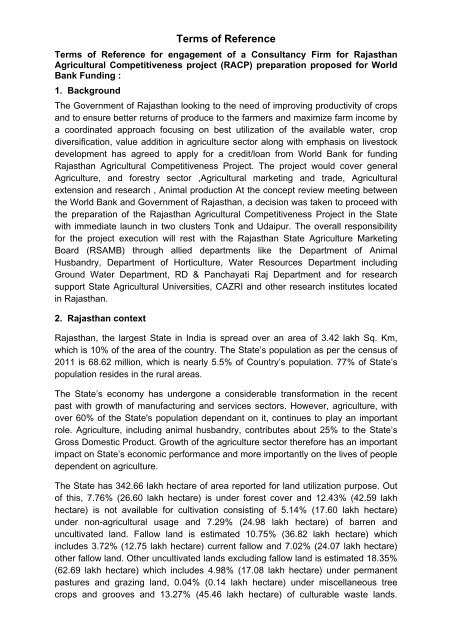
![dk;kZy; v/kh{kk vfHk;Urk] jktLFkku jkT; Ãf](https://img.yumpu.com/50574967/1/190x245/dkkzy-v-khkk-vfhkurk-jktlfkku-jkt-afk-foiku-cksmz-or-tks-kiqj.jpg?quality=85)
